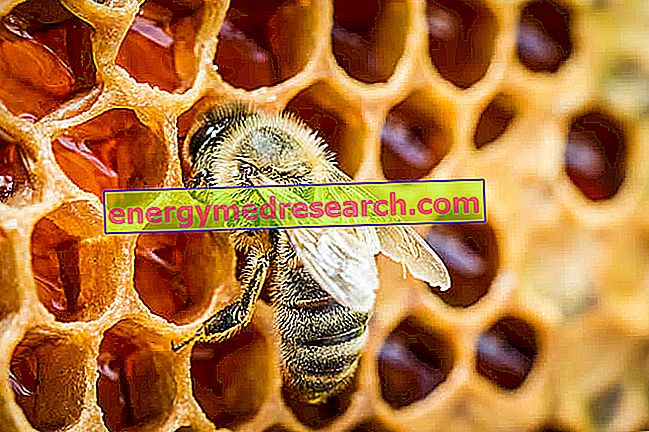In collaboration with Dr. Eleonora Roncarati
Definition
Honey is the food product (natural sweet substance) that domestic bees ( Apis mellifera ) produce from the nectar of flowers or from secretions from living parts of plants or that are on the same, which they spoil, transform, combine with specific substances own, they deposit, dehydrate, store and leave to mature in honeycombs (DL May 21st 2004, n. 179).
In the above definition, the dual origin - plant and animal - of honey is indicated. Honey is, in fact, the sugary substance processed by honey bees and NOT by other insects, which originates from the nectar of flowers or honeydew, and NOT from other sugary products; no substance can be added to or subtracted from the bee product, because it can be called honey.

Types of honey
Depending on the origin, we distinguish:
- flower honey or nectar honey, obtained from plant nectar; NETTARE is the sugary liquid secreted by the Angiosperms nectary, with a priming function for insects; it consists essentially of water and 3 sugars: glucose, fructose and sucrose. There are also small amounts of other sugars and aromatic substances, mineral salts, organic acids, amino acids and enzymes; the composition of the nectar, relatively constant for each botanical species, directly conditions the composition of the resulting honey. The transformation into honey is carried out by enzymatic means in the digestive tract of bees.
- honeydew honey, obtained mainly from substances secreted by sucking insects found on living parts of the plant. MELATA: are small viscous droplets, rich in sugary substances, produced by the aerial parts of plants. It is a derivative of tree sap, produced by some sucking insects such as metcalfa, which transform plant sap by retaining nitrogen and expelling excess liquid rich in sugars. This solution, called honeydew, remains on the surface of the leaves and branches of the plants that host the parasitic insects and is collected by bees and other insects; honeydew damages the plant because it represents a loss of energetic substances and because these sugary substances are an ideal substrate for the development of saprophytic fungi.
Depending on the method of production or extraction we distinguish:
- honey comb (stored by bees in the honeycomb cells they built from thin wax sheets, essentially made from beeswax, and sold in combs even whole)
- honey with honeycomb pieces or honeycomb sections in honey (which contains one or more pieces of honey in a comb)
- drained honey
- centrifuged honey
- grilled honey
- filtered honey .
Honey for industrial use used as an ingredient in other food products intended for later processing may have:
- abnormal taste and smell
- have begun a fermentation process or be effervescent
- having been overheated.
Production and processing techniques
Although honey is not a perishable food, the techniques that can be applied during production processes must take into account certain precautions and, first of all, a basic principle, that of offering the consumer a product that preserves as much as possible all the characteristics that it presents when bees have placed it in the cells of honeycombs in the hive.
PRECAUTIONS because the product obtained can be considered of high quality and MORE RISKS TO AVOID:
- The apiary must be far from any possible source of pollution, such as urban settlements, industrial sites, high traffic roads etc ..., as well as attention must be paid to whether bees can collect sugary substances other than nectar or honeydew .
- Periodic replacement of queen bees and old honeycombs.
- Correct use of the smoker, so as to prevent an excessive amount of smoke from compromising the organoleptic characteristics of the product.
- Avoid using repellent chemicals to remove bees from honeycombs, as these could contaminate the honey. For this purpose, traditional mechanical means such as brushes or air blowers used with a queen-free grill are recommended.
- The transport of the supers must occur by applying the appropriate protections; the storage of the empty supers in the winter period must take place in fresh and dry rooms and must exclude the use of insecticides that could stick to the wax and then be transmitted to the honey.
- The principles of HACCP (risk analysis and critical control points) must be rigorously applied, which also requires companies in this sector to identify any phase that may prove critical for the safety of honey and to ensure that they are identified, maintained and updated. the appropriate security procedures.
- Keep in mind that any thermal intervention (during the honey preparation phases described or the application of other technologies for example to thin the product) leads to a degradation of the product, a phenomenon that can range from the loss of aromatic and more thermolabile substances up to to a real compromise of the product, the more evident the higher the temperature and, even more, the application time of the heat treatment. In principle, the temperature of 40 ° C can be considered in itself not harmful to honey, but if applied for a few days, the damage can be greater than that caused by a temperature of 70 ° C for a few minutes.
- Another serious risk that honey can face is an excess of moisture. In fact, since honey tends to establish a balance with the atmosphere in which it is found, it can absorb moisture from a humid environment. For honey to be preserved well, its water content must be less than 18-20%.
(1) Production of honey by bees
The production of honey begins in the goiter of the worker, during her flight back to the hive. In the goiter, the invertase, an enzyme that has the property of breaking down sucrose into glucose and fructose, is added to the nectar, producing a chemical reaction, hydrolysis, which gives glucose and fructose. Arrived in the hive, the bee regurgitates the nectar, rich in water, which must then be dehydrated to ensure its conservation. For this purpose, the foragers deposit it in thin layers on the cell wall. The fan workers keep a stream of air in the hive that causes the water to evaporate. When this is reduced to a percentage of 17 to 22%, the honey is ripe. It is then stored in other cells, which once full will be sealed (opercolate). At the beginning of the nectariferous flow, the colony is given space for the deposition of the nectar, collected in the form of supers or hive bodies, possibly separated from the nest with a grid excluding the queen. At the end of the harvest (or when the supers are full) the supers are picked up using a suitable system to eliminate the bees from them.
- The simplest method consists in taking the combs one by one, eliminating the bees that cover them by shaking them and brushing them.
- An alternative system consists of interposing a diaphragm between nest and supers to provide a device that allows the passage of bees in one direction (apiscampo) so that, within a day, the supers are free from bees and can be taken.
- Another system widely used, but absolutely not recommended due to the possible negative consequences on the quality of honey, is the use of chemical repellents (phenic acid, benzaldehyde, nitrobenzene). The vapors that are released oblige the bees to move away (towards the nest) and make the honeycombs free from bees in a few minutes.
- A more modern and equally rapid technique is the use of an air current generator (blower) with which the bees are forcibly expelled from the supers.
IMPORTANT: some of the honey quality parameters depend directly on the production techniques adopted.
The most generalized aspect of interest is undoubtedly the water content, on which depends the preservability of the honey (lower, safer). Even if the water content can be modified after the collection of the supers, the most common practice remains to extract from the hives only the honey that has reached the right degree of ripeness. In general, honey is ripe when it is found in completely or almost completely opercular honeycombs. You must avoid collecting combs in which fresh nectar has just been deposed, which, with its high moisture content, can "dilute" the entire batch to risk levels. In some cases, however, the efforts of the beekeeper are not sufficient to ensure the production of honeys with optimal humidity. This is the case in environments where ambient humidity always remains at very high values; it is then possible to intervene in any other way to ensure adequate preservation of honey (see below).
The analysis of the phases of honey processing follows (set of procedures that the beekeeper performs to obtain honey in a marketable form):
- uncapping
- Demelatura or extraction
- Decantation and Filtration
- Heating
- Prevention of fermentation or PASTEURIZATION
- Preparation of liquid honey
- Guided crystallization techniques
- Invasettamento
- Storage
- storage



